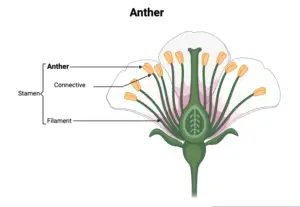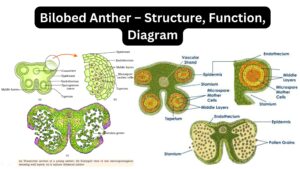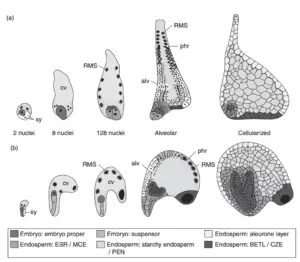What is Pollination?
- Pollination is a crucial biological process in flowering plants, involving the transfer of pollen from the anther, the male reproductive part, to the stigma, the female reproductive part. This process facilitates fertilization and the subsequent development of seeds, ensuring the continuation of plant species.
- The pollen grains, which contain male gametes, are transferred through various mechanisms. These include biotic vectors such as insects, birds, and bats, which actively carry pollen from one flower to another. Additionally, abiotic agents such as wind and water can disperse pollen across different plants. In some cases, plants may even use their own mechanisms to achieve pollination.
- Successful pollination typically requires that pollen be transferred to a stigma of the same species to ensure compatibility and successful fertilization. This specificity helps in maintaining genetic integrity and promoting successful seed development.
- Pollination can be categorized into two primary types: cross-pollination and self-pollination. Cross-pollination involves the transfer of pollen between different plants of the same species, often facilitated by external pollinators. In contrast, self-pollination occurs when pollen from a flower fertilizes ovules of the same flower or another flower on the same plant. Both mechanisms play critical roles in plant reproduction, with each type having its own set of advantages and ecological implications.
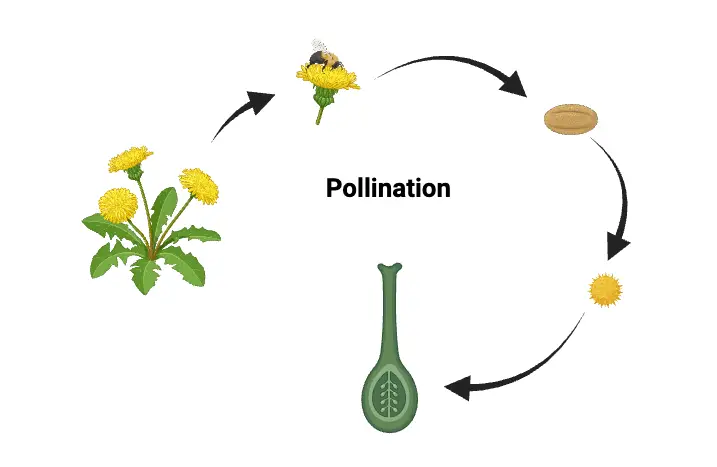
Definition of Pollination
Pollination is the transfer of pollen from the male part (anther) of a flower to the female part (stigma) of the same or another flower, enabling fertilization and seed production.
Process of Pollination
Pollination is a critical phase in the reproductive cycle of flowering plants, involving several key steps:
- Pollen Transfer:
The process begins with the transfer of pollen grains from the anther, the male reproductive organ of a flower, to the stigma, the female reproductive organ. This transfer can be facilitated by various agents such as wind, insects, or animals. - Pollen Germination:
Upon reaching the stigma, the pollen grain germinates. This involves the formation of a pollen tube, which grows through the style, a canal that connects the stigma to the ovary. The pollen tube serves as a conduit for the pollen grain to deliver male gametes to the ovary. - Pollen Tube Growth:
The pollen tube extends down the style toward the ovary. This growth is directed by chemical signals and requires a suitable environment within the style to proceed. - Sperm Cell Transmission:
Once the pollen tube reaches the ovary, it releases sperm cells into the ovule. This is where fertilization occurs. The sperm cells travel through the tube to reach the ovule, completing the transfer of male gametes. - Fertilization:
Fertilization takes place when a sperm cell successfully fuses with the egg cell within the ovule. This fusion results in the formation of a zygote, which will develop into a seed. - Seed Development:
Following fertilization, the fertilized ovule develops into a seed. The seed will then be dispersed from the parent plant, either through various mechanisms such as wind, animals, or water. - Reproductive Cycle Continuation:
The seed germinates under suitable conditions, growing into a new plant. This new plant will eventually complete its own pollination process, continuing the reproductive cycle.
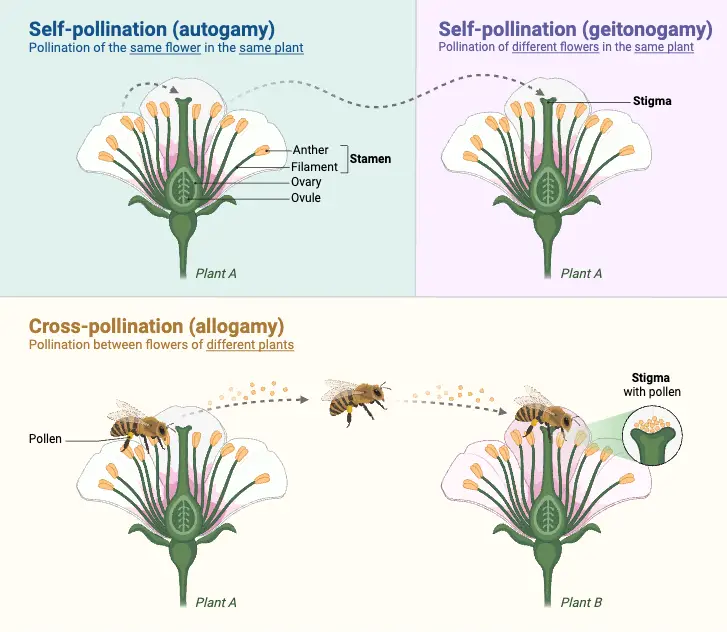
Pollination is a fundamental process in the reproductive cycle of flowering plants, involving the transfer of pollen grains from the anther to the stigma of a flower. This transfer can occur through three principal mechanisms:
- Autogamy
- Definition: Autogamy refers to the process where pollen from the anther of a flower falls onto the stigma of the same flower.
- Function: This form of self-pollination ensures that a plant can reproduce even in the absence of external pollinators. It is particularly beneficial for plants in isolated environments where pollinator availability is limited.
- Key Characteristic: Since the pollen and stigma belong to the same flower, genetic variation is limited, but it ensures reproductive success in stable environments.
- Geitonogamy
- Definition: Geitonogamy involves the transfer of pollen from the anther of one flower to the stigma of another flower on the same plant.
- Function: Although it still involves the same genetic material as autogamy, geitonogamy increases the chances of successful pollination across multiple flowers within the same plant, promoting reproductive efficiency.
- Key Characteristic: Geitonogamy is considered a form of self-pollination, but it can mimic cross-pollination if flowers are spaced apart on the plant.
- Allogamy
- Definition: Allogamy, or cross-pollination, occurs when pollen is transferred from the anther of one plant to the stigma of a flower on another plant of the same species.
- Function: Allogamy promotes genetic diversity by combining genetic material from different plants. This diversity is crucial for the adaptability and evolution of plant species.
- Key Characteristic: Cross-pollination is facilitated by various external agents such as wind, water, insects, or animals, which help transfer pollen between plants.
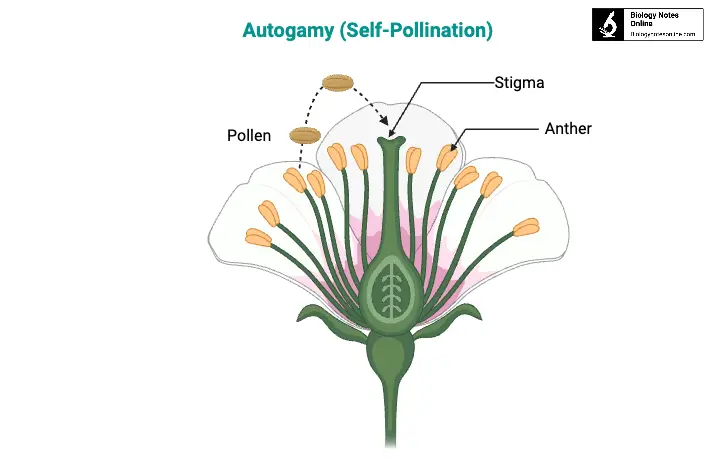
Agents of Pollination
Pollination is a fundamental process in plant reproduction, reliant on both biotic and abiotic vectors. Each type of pollination agent plays a distinct role in facilitating the transfer of pollen from the male anther to the female stigma, thus enabling fertilization.
Biotic Pollinators
- Bees (Melittophily): Bees are primary pollinators for many flowering plants. They are attracted to flowers by their color and scent and collect nectar and pollen, which they transfer to other flowers, promoting cross-pollination. Examples of plants pollinated by bees include Begonias.
- Butterflies (Psychophily): Butterflies pollinate flowers as they feed on nectar. They are drawn to brightly colored flowers and help in pollination by transferring pollen between flowers. Orchids are commonly pollinated by butterflies.
- Moths (Phalaenophily): Moths are nocturnal pollinators, attracted to flowers with strong scents that are usually white or pale-colored to be visible at night. Plants like Datura are pollinated by moths.
- Flies (Myophily): Certain flowers emit odors that attract flies, which help in transferring pollen. Flowers pollinated by flies, such as Primrose, often have strong, sometimes unpleasant scents.
- Beetles (Cantharophily): Beetles are attracted to flowers with strong odors and high nectar content. They are significant pollinators for plants like Magnolias and Water Lilies.
- Birds (Ornitophily): Birds, particularly hummingbirds, pollinate flowers as they feed on nectar. They are attracted to brightly colored flowers with tubular shapes. Bird of Paradise is an example of a plant pollinated by birds.
- Bats (Chiropterophily): Bats pollinate large, often fragrant flowers that open at night. They are essential for plants such as the Agave and African Baobab.
- Carrion Flies (Sapromyophily): Carrion flies pollinate flowers that emit foul smells, such as the Dead Horse Arum Lily. These flowers mimic the scent of rotting flesh to attract these flies.
Abiotic Pollinators
- Wind (Anemophily): Wind pollination is common in many plants, especially those with lightweight, non-sticky pollen grains that are easily carried by air currents. Plants such as grasses and corn use wind for pollination, and their flowers often feature exposed stamens and large, feathery stigmas.
- Water (Hydrophily): Water pollination is relatively rare and primarily occurs in aquatic plants. For instance, Vallisneria uses long stalks to reach the water surface for pollen release, while sea grasses release pollen underwater. This method of pollination is more common among lower plants like bryophytes.
- Rain (Ombrophily): In regions with frequent rain, some plants use rain-splash for pollination. This method helps in self-pollination when pollinators are scarce, providing a reproductive assurance strategy under adverse conditions.
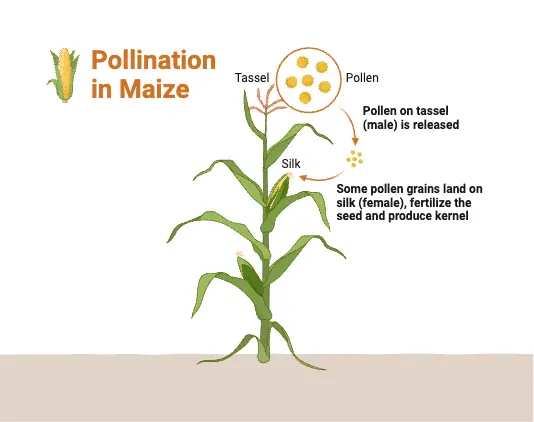
Types of Pollination
Pollination is a vital process for the reproduction of flowering plants and can be classified into two main types: autogamy and allogamy.
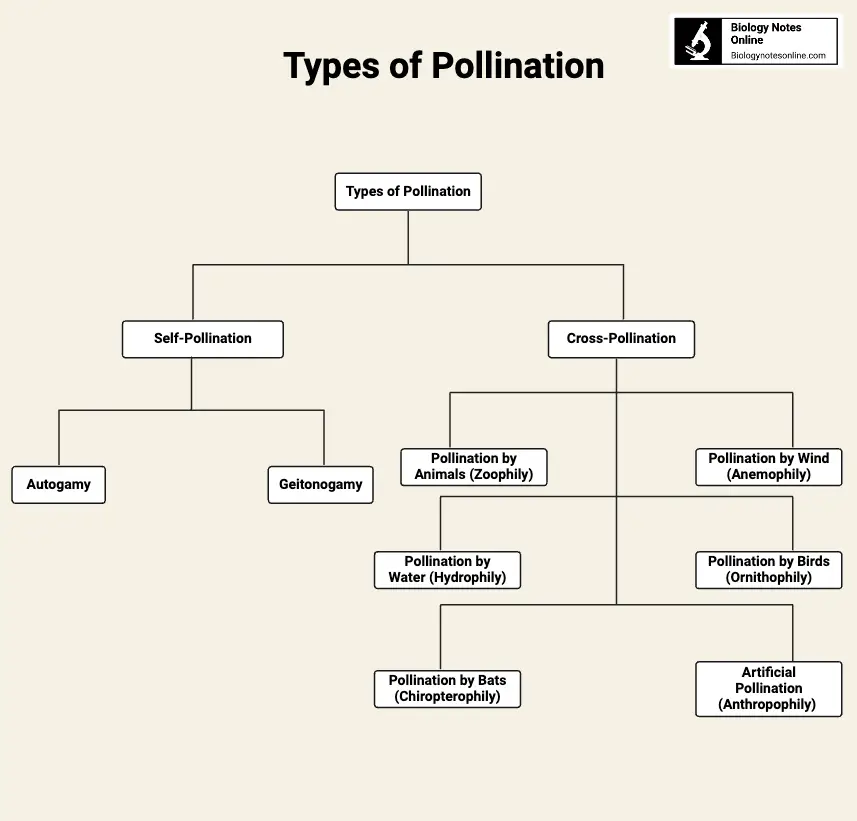
- Autogamy (Self-Pollination):
- Definition: Autogamy, or self-pollination, occurs when pollen from the anther of a flower fertilizes the ovule of the same flower or another flower on the same plant.
- Mechanism: This type of pollination does not require external pollinators or environmental factors. It often involves flowers with mechanisms that facilitate the transfer of pollen within the same flower or plant.
- Advantages: Self-pollination ensures reproduction even in the absence of external pollinators, providing reproductive assurance under adverse conditions.
- Examples: Plants like tomatoes and peas commonly utilize self-pollination.
- Allogamy (Cross-Pollination):
- Definition: Allogamy, or cross-pollination, involves the transfer of pollen from the anther of one flower to the stigma of another flower, which may be on the same plant or a different plant of the same species.
- Mechanism: This type of pollination often relies on biotic or abiotic vectors, such as insects, birds, wind, or water, to facilitate the movement of pollen between flowers.
- Advantages: Cross-pollination promotes genetic diversity by combining genetic material from different plants, which can enhance adaptability and survival of the species.
- Examples: Many plants, such as apples and cucumbers, rely on cross-pollination for effective reproduction.
Self-Pollination
- Autogamy, or self-pollination, is a reproductive mechanism where pollen grains from the anther of a flower fertilize the stigma of the same flower or another flower on the same plant. This process ensures that a plant can reproduce without the need for external pollinators or environmental factors.
- During self-pollination, the genetic material of the pollen and ovule comes from the same plant, which results in offspring with reduced genetic diversity compared to cross-pollination. This reduction in diversity can impact the adaptability and resilience of the plant species.
- Self-pollination can occur in both angiosperms (flowering plants) and gymnosperms (non-flowering plants like conifers). In angiosperms, this process often involves mechanisms such as flowers that are structured to facilitate the transfer of pollen within the same flower or between flowers on the same plant. Gymnosperms may also exhibit self-pollination, though their reproductive structures are generally adapted for different pollination strategies.
- Overall, autogamy provides a reliable means of reproduction, particularly in environments where pollinators are scarce or absent. However, the reduced genetic variation resulting from self-pollination can be a limiting factor for long-term evolutionary adaptability.

Types of Self Pollination
Self-pollination, or autogamy, encompasses two primary types: autogamy and geitonogamy. Each type involves different mechanisms and processes for the transfer of pollen within the same plant.
- Autogamy:
- Definition: Autogamy is a form of self-fertilization where pollen grains from the anther of a flower fertilize the stigma of the same flower. This process involves the fusion of gametes from the same individual.
- Mechanism: This type of pollination typically occurs within a single flower, minimizing the need for external pollinators. Autogamy ensures reproduction even in the absence of biotic or abiotic pollination agents.
- Implications: While autogamy guarantees successful reproduction, it often results in offspring with reduced genetic diversity due to the lack of genetic mixing. This limited variation can affect the adaptability of the species.
- Examples: Autogamy is commonly observed in crops such as wheat, rice, and peas, where plants have evolved mechanisms to promote self-fertilization.
- Geitonogamy:
- Definition: Geitonogamy involves the transfer of pollen grains from the anther of one flower to the stigma of another flower on the same plant. Although functionally similar to cross-pollination, geitonogamy occurs within a single plant.
- Mechanism: This type of self-pollination requires the involvement of pollinating agents, such as wind, insects, or birds. Pollinators visit multiple flowers on the same plant, facilitating the transfer of pollen between them.
- Implications: Geitonogamy, while still resulting in genetically similar offspring, mimics the process of cross-pollination by involving different flowers. This can help increase the genetic variation slightly compared to strict autogamy.
- Examples: Geitonogamy is observed in monoecious plants like maize, where separate flowers on the same plant can contribute to the pollination process.
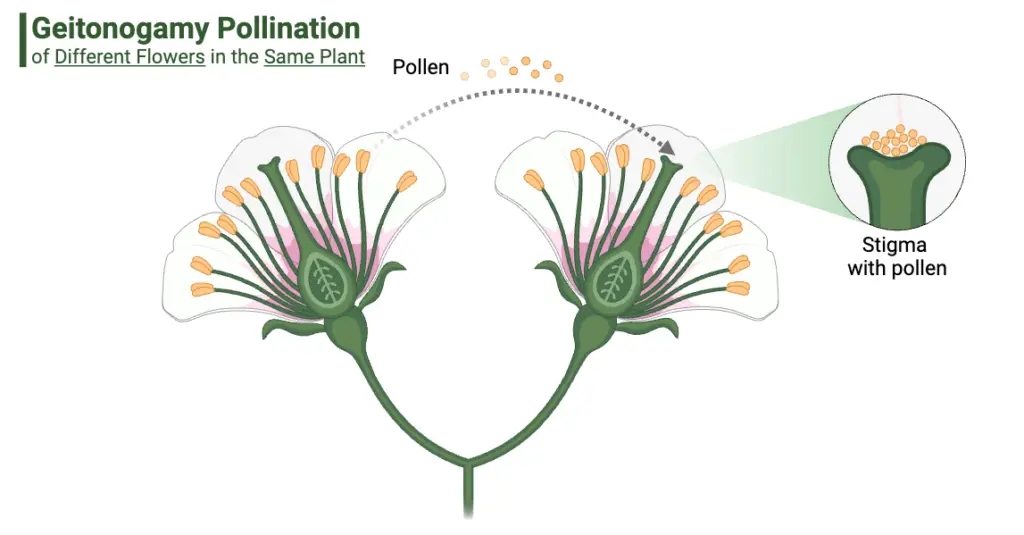
Adaptations for Self Pollination
Self-pollination, or autogamy, is facilitated by various plant adaptations that enhance the likelihood of pollen transfer within the same plant. These adaptations can be broadly categorized into structural and functional mechanisms.
- Bisexual or Hermaphroditic Flowers:
- Definition: Bisexual or hermaphroditic flowers contain both male (stamens) and female (pistils) reproductive organs within the same flower.
- Function: This dual presence allows for self-pollination as pollen can directly fertilize the stigma within the same flower, ensuring reproductive success without the need for external pollinators.
- Examples: Many plants exhibit this adaptation, such as certain species of lilies and tomatoes.
- Homogamy:
- Definition: Homogamy occurs when the anthers and stigma of a flower mature simultaneously.
- Function: This synchronization ensures that pollen is available to fertilize the stigma at the same time, facilitating self-pollination.
- Examples: Plants like Mirabilis jalapa, Argemone mexicana, Grewia asiatica, and Catharanthus display this adaptation. In Mirabilis, for instance, the filaments of the stamens recoil to bring the anthers closer to the stigma, promoting self-pollination.
- Cleistogamy:
- Definition: Cleistogamy refers to flowers that never open, thereby ensuring that pollen is shed within a closed flower and self-pollination is obligatory.
- Function: This adaptation ensures that the flower remains closed, and pollen transfer occurs within the same flower or between flowers on the same plant. It is particularly useful in environments where pollinators are rare or unreliable.
- Examples: Plants with cleistogamous flowers include Commelina benghalensis (which has inconspicuous underground flowers) and Impatiens balsamina. These plants also bear chasmogamous flowers, which are open and showy, above ground.
- Chasmocleistogamous Plants:
- Definition: These plants produce both chasmogamous (open) and cleistogamous (closed) flowers.
- Function: The presence of both flower types allows for flexibility in reproduction. Cleistogamous flowers ensure self-pollination under unfavorable conditions, while chasmogamous flowers can attract pollinators when conditions are more favorable.
- Examples: Species such as Viola tricolor, Oxalis, and Saxifraga exhibit this adaptive strategy.
Conditions for Self-Pollination
Self-pollination is a reproductive strategy in plants where pollen from the same flower or plant fertilizes its ovules, leading to seed production without the need for external pollen sources. Several conditions and mechanisms facilitate this process:
- Monocliny or Bisexuality:
- Definition: Monocliny, also known as bisexuality, refers to the presence of both male (stamens) and female (pistils) reproductive organs within a single flower or on the same plant.
- Function: This arrangement is crucial for self-pollination, as it ensures that the plant has all necessary reproductive parts in one location, facilitating the transfer of pollen to the stigma of the same flower.
- Homogamy:
- Definition: Homogamy describes the condition where the male and female reproductive structures within a flower mature simultaneously.
- Function: This temporal alignment allows for the pollen to fertilize the ovules within the same flower effectively, thereby promoting self-pollination.
- Chasmogamy:
- Definition: Chasmogamy refers to the opening of flowers for pollination, often occurring after the flower buds have initially closed.
- Function: In some plants, such as cereals like wheat and barley, flowers may initially close and later open, allowing for cross-pollination when the flowers are open. However, self-pollination can also occur during the initial closed phase.
- Cleistogamy:
- Definition: Cleistogamy involves flowers that do not fully open and are thus capable of self-pollination within a closed environment.
- Function: This strategy ensures that pollination occurs without the need for external agents. In species like California oat grass, and in plants like tomatoes and eggplants, the flowers remain closed, with the anthers and stigmas positioned to facilitate self-pollination.
- Floral Morphology:
- Definition: The arrangement of floral parts can also influence self-pollination. In some species, the anthers are closely positioned around the stigma or are otherwise covered by other floral organs.
- Examples: In legumes such as peas, mung beans, soybeans, and chickpeas, the floral organs can be structured to favor self-pollination. The flowers may open partially, but their morphology ensures that the stamens and stigmas are effectively positioned for self-pollination.
- Receptive Stigmas:
- Definition: In some plants, stigmas are elongated through the stamen columns, becoming receptive to their own pollen.
- Function: This adaptation ensures that the pollen from the same plant can effectively reach the receptive stigmas, facilitating self-pollination.
| Category | Mechanism | Description | Function |
|---|---|---|---|
| Mechanisms that Prevent Self-Pollination | Natural Mechanism: Dichogamy | Dichogamy involves the timing of pollen release and stigma receptivity being out of sync within the same flower. | Prevents self-pollination by ensuring that male and female reproductive organs are active at different times. |
| Chemical Mechanism: Self-Incompatibility | Chemical substances in the plant prevent self-pollination. Pollen may fail to germinate or the pollen tube may not grow normally on the same flower’s stigma. | Ensures that only pollen from genetically different plants can fertilize the ovules, preventing self-pollination. | |
| Mechanisms that Permit Self-Pollination | Perfect Flower (Bisexual or Hermaphroditic Flower) | Perfect flowers have both male and female reproductive organs in the same flower, allowing for self-pollination when pollen release and stigma receptivity are synchronized. | Ensures that pollen transfer within the same flower leads to self-fertilization. |
| Homogamy | Refers to the simultaneous maturation of male and female reproductive organs within a flower. | Promotes self-pollination by aligning the timing of pollen release with stigma receptivity. | |
| Cleistogamy | Pollination and fertilization occur within a closed flower before it opens. | Guarantees self-pollination even in the absence of external pollinators or favorable environmental conditions. |
Advantages of Self- Pollination
Self-pollination, or autogamy, offers several distinct advantages, contributing to the reproductive efficiency and stability of plant species. These advantages are particularly relevant in environments where external pollinators are scarce or unreliable.
- Reduced Pollen Wastage:
- Description: Self-pollination minimizes the loss of pollen grains compared to cross-pollination, where pollen may be dispersed without reaching the stigma.
- Function: By ensuring that pollen from the same plant fertilizes the stigma, there is less likelihood of pollen being wasted.
- Consistent Harvest Quality:
- Description: In agricultural practices, self-pollination ensures a standard quality of produce, such as vegetables, by reducing variability in seed development.
- Function: This consistency is crucial for farmers seeking uniform crop yields and quality.
- Elimination of Recessive Traits:
- Description: Self-pollination can help in eliminating recessive genetic traits that might be detrimental if they were expressed.
- Function: By promoting the expression of dominant traits, plants can potentially avoid some genetic disorders.
- Independence from Pollinators:
- Description: Self-pollinating plants do not rely on external agents such as bees, wind, or water for pollination.
- Function: This reduces dependency on environmental factors and external biological agents, making reproduction more predictable.
- Lower Effort Requirements:
- Description: Plants that self-pollinate do not need to invest resources in attracting pollinators.
- Function: This means they do not need to produce scents, nectar, or bright colors, which are typically used to attract pollinators in cross-pollinating plants.
- Effective Use of Minimal Pollen:
- Description: Even a small amount of pollen can be effectively used in self-pollination to achieve successful fertilization.
- Function: This is particularly advantageous in environments where pollen availability is limited.
- Preservation of Genetic Properties:
- Description: Self-pollination helps preserve the genetic makeup of a species by consistently passing on genetic traits.
- Function: This ensures the retention of specific genetic characteristics within a population.
- Increased Seed Production Reliability:
- Description: Plants that self-pollinate generally have a higher success rate in seed production.
- Function: This leads to fewer failures in reproduction, ensuring more reliable seed generation.
Disadvantages of Self- Pollination
Self-pollination, while advantageous in some contexts, has several notable disadvantages. These drawbacks primarily stem from the lack of genetic diversity and the inherent limitations in adaptability and seed quality.
- Limited Gene Mixing:
- Description: Self-pollination does not facilitate gene mixing between different individuals.
- Function: This lack of genetic recombination results in offspring that are genetically similar to the parent plant, potentially limiting diversity.
- Reduced Seed Quantity:
- Description: Plants that rely solely on self-pollination often produce fewer seeds compared to those that engage in cross-pollination.
- Function: The lower seed output can affect the overall reproductive success and survival of the species.
- Decreased Genetic Diversity:
- Description: Offspring from self-pollination exhibit reduced genetic variation.
- Function: Reduced diversity leads to decreased immunity to diseases and pests, making the plants more susceptible to environmental stresses and pathogen attacks.
- Lower Seed Quality:
- Description: Seeds produced through self-pollination are often of lower quality.
- Function: This can affect seed viability, growth potential, and overall plant health.
- Lack of Adaptability:
- Description: Self-pollination does not introduce new genetic traits into the population.
- Function: This limits the plant’s ability to adapt to changing environments or evolving pathogens, potentially reducing its long-term survival.
- Inhibition of New Varieties:
- Description: The process does not create new plant varieties.
- Function: This lack of variety limits the potential for evolutionary advancements and innovation within the species.
- Failure to Eliminate Weak Strains:
- Description: Self-pollination does not effectively remove weaker genetic strains.
- Function: This can lead to the persistence of less favorable traits within the population.
| Advantages of Self-Pollination | Disadvantages of Self-Pollination |
|---|---|
| 1. Reduced Pollen Wastage: Less pollen is wasted compared to cross-pollination. | 1. Limited Gene Mixing: Gene mixing does not occur, leading to reduced genetic diversity. |
| 2. Standard Harvest Quality: Ensures consistent quality in crops. | 2. Reduced Seed Quantity: Typically produces fewer seeds. |
| 3. Elimination of Recessive Characters: Recessive genetic traits are less likely to persist. | 3. Decreased Genetic Diversity: Offspring have less immunity to diseases. |
| 4. No Reliance on Pollinators: Does not depend on external agents like bees or wind. | 4. Lower Seed Quality: Seeds are often of lower quality and viability. |
| 5. Less Effort Required: Plants do not need to attract pollinators. | 5. Lack of Adaptability: Reduced ability to adapt to environmental changes or pathogen attacks. |
| 6. Effective with Small Pollen Quantity: A small amount of pollen can achieve successful pollination. | 6. Prevention of New Varieties: Limits the creation of new plant varieties. |
| 7. Consistent Seed Production: Ensures reliable seed production. | 7. Retention of Weaker Strains: Weaker genetic strains are not eliminated. |
| 8. Fewer Pollination Failures: Lower chances of pollination failure. | |
| 9. No Need for Attractive Features: Flowers do not need to produce scent, nectar, or colorful petals to attract pollinators. |
What is Cross-Pollination?
- Cross-pollination is a fundamental reproductive process in flowering plants, occurring when pollen grains from the anther of one flower are transferred to the stigma of a different flower on another plant. This transfer of pollen between distinct plants facilitates the fusion of genetic material from separate individuals, leading to offspring with increased genetic diversity. This genetic variation contributes to the uniqueness of each new generation, which can enhance adaptability and resilience.
- During cross-pollination, pollen from one flower must reach the pistil of another flower, which typically happens between flowers of the same species but on different plants. Unlike self-pollination, where genetic material remains within a single plant, cross-pollination involves the exchange of genetic information between separate individuals. This process is often mediated by various pollinating agents such as insects, bees, birds, or even wind. The involvement of these external agents is crucial, as they help transfer pollen from one plant to another, ensuring that the genetic mixing takes place.
- Cross-pollination can be further categorized into several types, each defined by the nature of the pollinating agents and the specific mechanisms through which pollen is transferred. These types include mechanisms such as entomophily (pollination by insects), ornithophily (pollination by birds), and anemophily (pollination by wind), each playing a distinct role in the reproductive strategies of different plant species.
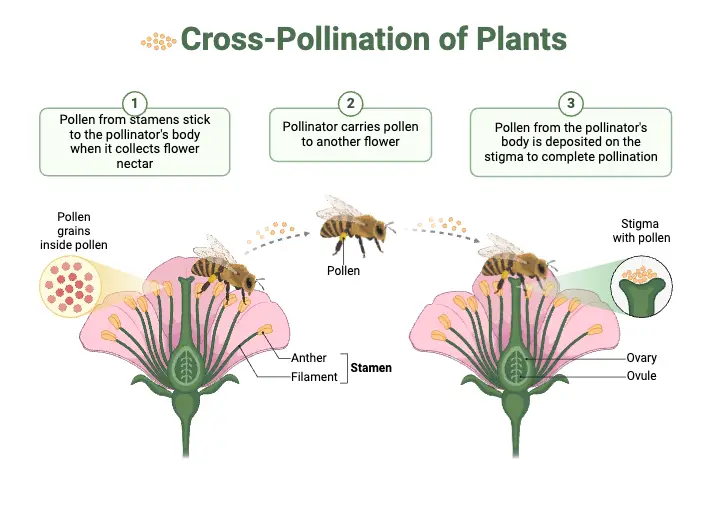
Types of Cross-Pollination
Cross-pollination involves the transfer of pollen between different flowers, facilitated by various agents. This process can be categorized based on the nature of the pollinating agents and mechanisms involved. The primary types of cross-pollination include:
- Pollination by Animals (Zoophily) Zoophily, or animal pollination, occurs when animals such as insects, birds, and mammals transfer pollen between flowers. Animals play a crucial role in plant reproduction by moving pollen from one flower to another, often while feeding on nectar or fruit. Examples of plants that benefit from zoophily include cotton and lychee, where insects like bees are key pollinators.
- Pollination by Wind (Anemophily) Anemophily involves the transfer of pollen through air currents. Wind-pollinated plants typically have small, inconspicuous flowers that do not produce nectar or scent. They release large quantities of lightweight, airborne pollen to ensure effective distribution. Common examples of wind-pollinated plants are grasses such as corn and wheat, as well as many gymnosperms.
- Pollination by Water (Hydrophily) Hydrophily is a method where water acts as the medium for pollen transfer. This type of pollination is common among aquatic plants, which have adaptations like long, sticky stigmas and unwettable pollen grains. Plants such as water lilies and seagrasses rely on water to transport pollen, making them well-suited for their aquatic environments.
- Pollination by Birds (Ornithophily) Ornithophily, or bird pollination, occurs when birds transfer pollen between flowers. Plants that utilize this method often have bright-colored, tubular flowers and produce large amounts of nectar to attract birds. Examples of bird-pollinated plants include certain species of fuchsia and salvia, which are visited by hummingbirds and sunbirds.
- Pollination by Bats (Chiropterophily) Chiropterophily involves bats as the primary pollinators. This type of pollination is typically found in tropical and desert regions, where plants often bloom at night. Bat-pollinated flowers are usually white or dull-colored, open at night, and emit a strong odor to attract bats. Agave plants are a notable example, relying on bats for successful pollination.
- Artificial Pollination (Anthropophily) Artificial pollination, or anthropophily, is conducted by humans who manually transfer pollen to facilitate plant reproduction. This technique is often employed in hybridization and breeding programs to achieve specific traits in crops. It involves spreading pollen grains over the female parts of plants, helping in controlled pollination scenarios.
Adaptations for Cross Pollination
Adaptations for cross-pollination are crucial for ensuring genetic diversity and reproductive success in various plant species. These adaptations involve different structural and functional mechanisms that prevent self-pollination and promote the transfer of pollen between different plants. The following points outline key adaptations that facilitate cross-pollination:
- Dicliny:
- Cross-pollination is predominant among diclinous plants, which bear unisexual flowers. In monoecious plants, where both male and female flowers are on the same plant, the only alternative to self-pollination is geitonogamy (transfer of pollen between flowers on the same plant).
- Self-Sterility or Self-Incompatibility:
- In some plants, pollen from a flower does not grow or grows very slowly if it falls on the stigma of the same flower, thereby preventing self-fertilization. This self-sterility is observed in species like Solanum (Potato, Tobacco) and the tea plant, often due to genetic reasons.
- Dichogamy:
- Dichogamy refers to the timing difference between the maturation of anthers and the receptivity of the stigma in the same flower. This adaptation can be of two types:
- Protandry: The anthers mature before the stigma becomes receptive. Examples include Saxifraga, Impatiens, Epilobium, Salvia, and many members of Umbelliferae and Malvaceae.
- Protogyny: The stigma matures first and loses its receptivity by the time the anthers shed their pollen. Examples include species in the Anonaceae (e.g., Anona, Polyalthia) and Magnoliaceae (e.g., Magnolia, Michelia), as well as Aristolochia and Arum maculatum. Protandry is more common in nature than protogyny.
- Dichogamy refers to the timing difference between the maturation of anthers and the receptivity of the stigma in the same flower. This adaptation can be of two types:
- Herkogamy:
- In bisexual flowers, certain structural features of the anthers and styles make self-pollination mechanically impossible. For instance, in Caryophyllaceae and Cruciferae, the style is much longer than the stamens, preventing the flower’s pollen from reaching its stigma. In Orchidaceae and Asclepiadaceae, pollens are united into a single compact pollinium, which can only be transported by insects like ants and beetles. The extrorse anthers of Gloriosa dehisce away from the flower’s own stigma, further preventing self-pollination.
- Heteromorphism:
- Some flowers exhibit dimorphism (two forms) or trimorphism (three forms) involving differences in anther and stigma lengths. This variation often includes heterostyly (styles of different lengths) and heteroanthy (different types of anthers). For example:
- Long-Styled Flowers: These flowers have a long style, with small stamens and smaller, oblong pollen grains.
- Short-Styled Flowers: These flowers have a stigma located below the anthers, about half the height of the corolla tube. Different types of insects, depending on their size and feeding habits, will naturally touch the floral organs at the same level, ensuring cross-pollination. Examples of plants exhibiting heteromorphism include members of Primulaceae, Oxalidaceae, Polygonaceae, Plumbaginaceae, Gentianaceae, Boraginaceae, and Rubiaceae.
- Some flowers exhibit dimorphism (two forms) or trimorphism (three forms) involving differences in anther and stigma lengths. This variation often includes heterostyly (styles of different lengths) and heteroanthy (different types of anthers). For example:
Conditions for Cross-Pollination
Cross-pollination is a crucial mechanism in plant reproduction that facilitates genetic diversity and ensures the successful transfer of pollen from one flower to another. Several conditions and mechanisms enable and promote this process:
- Dicliny or Unisexuality:
- Definition: Dicliny, also known as unisexuality, refers to flowers that possess only one type of reproductive organ—either male or female.
- Monoecious Plants: In these plants, male and female reproductive organs are present in separate flowers but on the same individual. This arrangement requires cross-pollination between different flowers on the same plant.
- Dioecious Plants: Here, male and female organs are located on different plants altogether. Cross-pollination is essential, as each plant carries only one type of reproductive organ.
- Dichogamy:
- Definition: Dichogamy involves the temporal separation of the maturation of male and female reproductive organs within a flower.
- Protandry: In protandry, the male parts mature before the female parts, reducing the likelihood of self-pollination.
- Protogyny: Conversely, protogyny is when the female parts mature before the male parts, similarly minimizing self-fertilization opportunities.
- Heterostyly:
- Definition: Heterostyly refers to the variation in the lengths of styles and stamens within flowers of the same species.
- Function: This structural variation ensures that pollen from one flower cannot easily fertilize the stigma of the same flower, thereby promoting cross-pollination. Different flower types with varying styles and stamens often coexist within the same plant population.
- Herkogamy:
- Definition: Herkogamy describes the physical separation between the anthers (pollen-producing parts) and the stigma (pollen-receptive parts) of a flower.
- Function: This spatial arrangement acts as a physical barrier, making it difficult for a flower’s own pollen to fertilize its stigma, thus facilitating cross-pollination between different flowers.
- Male Sterility:
- Definition: Male sterility is characterized by the absence of functional pollen grains or their inability to fertilize ovules.
- Function: In plants exhibiting male sterility, the pollen produced is either non-viable or absent, necessitating cross-pollination with pollen from other plants to achieve fertilization.
- Self-Incompatibility:
- Definition: Self-incompatibility is a genetically controlled mechanism that prevents self-fertilization by inhibiting the ability of pollen to fertilize ovules from the same plant.
- Function: This mechanism ensures that pollen from the same plant or flower cannot fertilize its ovules, thereby promoting cross-pollination and genetic variation.
Advantages of Cross-Pollination
Cross-pollination offers several significant advantages, primarily due to its ability to enhance genetic diversity and improve plant traits.
- Formation of New Varieties Cross-pollination facilitates the development of new crop and plant varieties. By transferring pollen between different individuals or even different species, it introduces new genetic combinations. This process can lead to the creation of plants with novel traits that may be more desirable or adaptable.
- Involvement of Unisexual Plants Unisexual plants, which have either male or female reproductive structures, can participate in cross-pollination. This process ensures that even plants with single-sex flowers can reproduce effectively by utilizing pollen from other individuals, thereby promoting genetic exchange.
- Increased Health of Offspring One of the primary benefits of cross-pollination is the increased genetic diversity it brings. The mixing of genetic material from different plants leads to offspring with enhanced health and vigor. This increased diversity often results in plants that are more resilient and better able to adapt to environmental challenges.
- Higher Seed Viability Seeds produced through cross-pollination tend to be more viable compared to those produced through self-pollination. This means that the seeds have a higher likelihood of germinating and developing into healthy plants, contributing to successful reproduction and growth.
- Greater Seed Production Cross-pollination typically results in the production of seeds in larger quantities. Plants that undergo cross-pollination often generate more seeds, which can enhance their chances of successful propagation and survival.
- Genetic Recombination During fertilization, genetic recombination occurs, leading to the mixing of hereditary traits. This recombination helps eliminate undesirable traits and can introduce beneficial characteristics, improving the overall genetic fitness of the plant lineage.
- Introduction of Variation Cross-pollination introduces variation within species. This variation can result in new traits that may offer advantages such as increased resistance to diseases or pests. Therefore, cross-pollination contributes to the evolutionary adaptability and survival of plant species.
Disadvantages of Cross-Pollination
Cross-pollination, while advantageous in many ways, also presents several challenges and drawbacks.
- Increased Pollen Wastage Cross-pollination often results in greater wastage of pollen grains compared to self-pollination. A significant amount of pollen is produced and dispersed, but only a fraction will successfully reach and fertilize the target flowers, leading to inefficiencies.
- Potential for Unwanted Genetic Recombination During meiosis, the process of genetic recombination can sometimes introduce undesirable traits. The combination of genetic material from different plants may result in offspring that possess fewer desirable characteristics or acquire new, less advantageous traits.
- Introduction of Undesirable Traits The genetic exchange involved in cross-pollination can occasionally introduce undesirable traits into the offspring. These traits may not be beneficial and can detract from the overall quality and adaptability of the plant.
- High Pollen Production Requirement Cross-pollination requires a large quantity of pollen to increase the likelihood of successful fertilization. This need for extensive pollen production can lead to significant waste, as only a small proportion of the pollen will effectively contribute to seed development.
- Potential for Pollination Failure Pollination may fail if the distance between plants is too great or if suitable pollinators are absent. This dependency on pollinators and environmental conditions means that successful fertilization is not guaranteed, which can affect plant reproduction.
- Uncertainty of Pollination Cross-pollination depends on the presence of pollinators or other mechanisms to transfer pollen between plants. If these pollinators are not present or are ineffective, the process of cross-pollination may not occur, reducing the chances of successful seed production.
- Genetic Recombination Risks The genetic recombination that occurs during cross-pollination carries the risk of eliminating advantageous traits from the parent plants. While recombination can introduce beneficial new traits, it can also result in the loss of established positive qualities.
| Advantages of Cross-Pollination | Disadvantages of Cross-Pollination |
|---|---|
| Increases genetic diversity, leading to healthier offspring. | Requires a large amount of pollen, resulting in significant wastage. |
| Produces new plant varieties with potentially beneficial traits. | Genetic recombination can introduce undesirable traits. |
| Seeds are more viable, with greater strength and survivability. | Pollination may fail due to distance or absence of pollinators. |
| Enhances adaptability and resistance to diseases in plants. | Risk of eliminating desirable traits during genetic recombination. |
| Allows unisexual plants to participate in reproduction. | Pollination is uncertain and dependent on external pollinators. |
| Facilitates the creation of plants with new and advantageous characteristics. | May introduce unnecessary or harmful traits to offspring. |
Difference Between Self-Pollination and Cross-Pollination
Here is the Difference Between Self-Pollination and Cross-Pollination:
- Definition:
- Self-Pollination: In self-pollination, pollen from the same flower or plant fertilizes the ovules within that flower or plant.
- Cross-Pollination: Cross-pollination involves the transfer of pollen from one flower or plant to the stigma of another flower or plant.
- Mechanism:
- Self-Pollination: The process occurs through autogamy (pollen transfer within the same flower) or geitonogamy (pollen transfer between flowers on the same plant).
- Cross-Pollination: This process requires the transfer of pollen between flowers on different plants, often facilitated by external agents.
- Genetic Diversity:
- Self-Pollination: Results in low genetic diversity since the offspring are genetically identical to the parent plant.
- Cross-Pollination: Promotes high genetic diversity as the offspring inherit genetic material from two different parent plants.
- Advantages:
- Self-Pollination: Does not rely on external pollinating agents and ensures fertilization even in isolated conditions.
- Cross-Pollination: Offers greater genetic variability, which enhances adaptability to changing environmental conditions.
- Disadvantages:
- Self-Pollination: Limited genetic diversity can make the population more susceptible to diseases and environmental changes.
- Cross-Pollination: Requires external agents such as wind, insects, or animals, making the process less certain.
- Examples:
- Self-Pollination: Common in plants like peas and tomatoes, where self-fertilization is possible.
- Cross-Pollination: Seen in plants like apples, cherries, watermelons, and zucchinis, where pollination often involves insects or wind.
- Dependency on Agents:
- Self-Pollination: Does not depend on external agents; relies on gravity, structural features, or self-transfer for pollination.
- Cross-Pollination: Requires external agents such as wind, insects, or animals for the successful transfer of pollen between flowers.
| Feature | Self-Pollination | Cross-Pollination |
|---|---|---|
| Definition | Pollen from the same flower or plant fertilizes the ovules within that flower or plant. | Pollen from one flower or plant is transferred to the stigma of another flower or plant. |
| Mechanism | Autogamy (transfer of pollen within the same flower) or geitonogamy (transfer of pollen between flowers on the same plant). | Involves the transfer of pollen between flowers on different plants. |
| Genetic Diversity | Low genetic diversity. Offspring are genetically identical to the parent plant. | High genetic diversity. Offspring inherit genetic material from two different parent plants. |
| Advantages | No dependency on external pollinating agents. | Greater genetic variability, promoting adaptability to changing environments. |
| Disadvantages | Limited genetic diversity, making the population susceptible to diseases and environmental changes. | Requires external agents (wind, insects, animals) for successful pollination. |
| Examples | Peas, tomatoes (some varieties can self-pollinate). | Apples, cherries, watermelons, zucchinis, where pollination often involves insects or wind. |
| Dependency on Agents | Not dependent on external agents; relies on gravity, structural features, or self-transfer. | Requires external agents (wind, insects, animals) for successful transfer of pollen between flowers. |
What are Outbreeding Devices?
Outbreeding devices are specialized mechanisms evolved by flowering plants to promote cross-pollination and prevent the negative effects of inbreeding. These devices are crucial for maintaining genetic diversity and ensuring the health and viability of plant offspring. The following points describe key outbreeding devices:
- Dicliny (Unisexuality):
- Monoecious Plants: These plants have both male and female flowers on the same individual, such as castor and maize. While this arrangement prevents self-pollination (autogamy), it does not entirely eliminate the possibility of pollen transfer between flowers on the same plant (geitonogamy).
- Dioecious Plants: In dioecious species, male and female flowers are on separate plants. This arrangement ensures that each plant is either male or female, thereby preventing both autogamy and geitonogamy.
- Dichogamy:
- In many bisexual flowers, the stamens (male reproductive organs) and carpels (female reproductive organs) mature at different times. This temporal separation can be categorized into:
- Protandry: The anthers mature and release pollen before the stigma becomes receptive.
- Protogyny: The stigma matures and is receptive before the anthers release pollen. This separation prevents self-pollination by ensuring that pollen is not available when the stigma is receptive, or vice versa.
- In many bisexual flowers, the stamens (male reproductive organs) and carpels (female reproductive organs) mature at different times. This temporal separation can be categorized into:
- Heterostyly:
- In species exhibiting heterostyly, the anthers and stigma are positioned at different heights within the flower. This spatial arrangement prevents self-pollination by ensuring that pollen from the anthers cannot reach the stigma of the same flower. Different flower forms within the same species may have varying anther and stigma lengths to facilitate cross-pollination.
- Self-Incompatibility:
- This genetic mechanism prevents self-pollen from fertilizing the ovules. Self-incompatibility functions by inhibiting the germination of pollen or the growth of the pollen tube within the pistil (the female reproductive organ). This ensures that pollen from the same flower or other flowers on the same plant cannot successfully fertilize the ovules, promoting cross-pollination instead.
What is Pollen Pistil Interaction?
Pollen-pistil interaction is a fundamental aspect of plant reproduction, involving a series of complex and coordinated events that facilitate fertilization. This process begins when pollen is deposited onto the stigma, which is the pollen-receptive part of the pistil. The interaction between pollen and pistil ensures that fertilization occurs only when compatible pollen reaches the ovule. Here is a detailed overview of this interaction:
- Recognition and Compatibility:
- Pollen Deposition: Pollen grains are transferred to the stigma of a flower. This initial contact is critical for subsequent events in the interaction.
- Chemical Dialogue: The pistil recognizes the compatibility of the pollen through chemical signals exchanged between pollen and stigma. This involves specific proteins and molecules on both pollen and pistil surfaces.
- Germination and Growth:
- Compatible Pollen: If the pollen is deemed compatible, it germinates on the stigma, producing a pollen tube. This tube grows through the stigma and style (the elongated part of the pistil) towards the ovary.
- Pollen Tube Formation: In some plant species, male gametes are produced during the pollen tube’s growth in the stigma, while in others, the pollen tube carries the male gametes from the start.
- Entry into the Ovule:
- Reaching the Ovule: The pollen tube navigates through the style and reaches the ovary. Here, it enters the ovule through an opening known as the micropyle.
- Penetration and Release: The pollen tube penetrates one of the synergid cells within the ovule using a structure called the filiform apparatus. The tip of the pollen tube bursts, releasing the male gametes into the synergid cells.
- Fertilization:
- Male Gamete Transfer: Once inside the synergids, the male gametes are positioned to fertilize the ovule. This leads to the fusion of male and female gametes, resulting in fertilization.
- Seed Formation: Following fertilization, the ovule develops into a seed, completing the reproductive cycle.
What is Artificial Hybridisation?
Artificial hybridisation is a controlled technique utilized in plant breeding to produce new plant varieties with specific, desirable traits. This process involves several key steps designed to ensure the successful cross-pollination of selected plants. Here is a detailed breakdown of the process:
- Emasculation:
- Definition: Emasculation is the removal of the anthers, which are the pollen-producing parts of a flower, before they release their pollen.
- Purpose: This step prevents self-pollination, ensuring that the flower cannot fertilize itself. It also ensures that only the chosen pollen will be used in the subsequent pollination process.
- Application: Typically performed on flowers with both male and female reproductive organs (bisexual flowers).
- Bagging:
- Definition: After emasculation, the flower is covered with a protective bag made from materials such as butter paper.
- Purpose: Bagging shields the stigma from any external pollen, ensuring that only the desired pollen is used. This helps maintain control over which pollen fertilizes the flower.
- Timing: The bagging occurs immediately after emasculation and before the stigma becomes receptive.
- Pollination:
- Definition: Pollination involves transferring mature pollen from the male parent to the stigma of the emasculated, bagged flower.
- Procedure: Once the stigma of the bagged flower is receptive, pollen collected from the anthers of the chosen male parent is applied to the stigma.
- Objective: This ensures that fertilization occurs with the desired pollen, leading to the development of seeds with the selected traits.
- Rebagging:
- Definition: Rebagging is the process of re-covering the flower after pollination has occurred.
- Purpose: This step protects the flower and developing seeds or fruits from any potential contamination by unwanted pollen. It ensures that the seeds or fruits result from the intended cross-pollination.
- Outcome: Ensures that the offspring produced will have the traits desired from the selected parent plants.
What is Double Fertilisation?
Double fertilisation is a distinctive process found exclusively in angiosperms (flowering plants), characterized by two distinct fertilization events within a single reproductive cycle. This process leads to the formation of two critical structures necessary for seed development. Here is an in-depth look at the steps and components involved:
- Pollen Germination and Tube Formation:
- Initial Steps: After pollen is deposited on the stigma, it absorbs water and nutrients, which trigger its germination. The pollen grain, consisting of a pollen tube cell and a generative cell, begins to grow a pollen tube through the style towards the ovule.
- Cell Functions: The pollen tube cell develops into the pollen tube, while the generative cell undergoes division to form two sperm cells. The pollen tube navigates through the style, guided by chemical signals secreted by synergid cells within the embryo sac.
- Syngamy (True Fertilisation):
- Process: One of the sperm cells travels through the pollen tube and fuses with the egg cell located in the ovule. This fusion forms a diploid zygote, which will develop into the embryo.
- Outcome: The zygote will eventually divide and differentiate into the embryo, forming the basis of the future plant.
- Triple Fusion:
- Process: The second sperm cell moves into the ovule and fuses with two polar nuclei in the central cell of the embryo sac. This fusion results in a triploid primary endosperm nucleus (PEN).
- Outcome: The PEN develops into the endosperm, a nutritive tissue that provides essential nutrients to the developing embryo.
- Formation of Seed and Fruit:
- Post-Fertilisation: Once fertilisation is complete, no additional sperm cells can enter the ovule. The fertilized ovule transforms into a seed, while the surrounding ovary tissues develop into the fruit, which encapsulates the seed.
- Embryo Development: After fertilisation, the zygote divides into two cells: the terminal cell and the basal cell. The basal cell forms the suspensor, which connects to the maternal tissue and facilitates nutrient transfer. The terminal cell divides to form a globular proembryo, which further develops into the mature embryo with distinct cotyledons.
- Embryo Growth and Seed Maturation:
- In Dicots: The embryo develops into a heart-shaped structure due to the presence of two cotyledons. In non-endospermic dicots, the endosperm is initially formed but later consumed, with food reserves relocated to the cotyledons.
- Seed Preparation: As the embryo and cotyledons enlarge, the seed undergoes morphological changes, eventually filling and preparing for dispersal. The embryonic development halts until the seed germinates. During germination, the embryo relies on the cotyledons’ stored nutrients until it can photosynthesize with its first leaves.
Flowers adaptations related to pollination
Flowering plants have evolved various adaptations to optimize pollination, ensuring successful reproduction and continuation of species. These adaptations are closely tied to the characteristics of the pollinators they attract. Here are key adaptations that flowers exhibit in relation to pollination:
1. Shape
- Specialized Floral Structures: The shape of flowers is often dictated by the type of pollinators they aim to attract. For instance, flowers adapted to bird pollination, such as those favored by hummingbirds, typically possess a tubular shape, which complements the long beaks of these birds. The floral tube is designed to store nectar at its base, encouraging the bird to reach deep into the flower, thereby facilitating pollen transfer.
- Landing Platforms: Flowers pollinated by bees frequently have a distinct landing platform, usually formed by the lower petal, providing a stable surface for bees to rest on while accessing nectar. This structure not only supports the bee but also positions it perfectly for effective pollen collection and deposition.
2. Fragrance
- Scent as an Attractant: Fragrance plays a significant role in attracting pollinators, particularly those active at night. For example, nocturnal flowers, such as jasmine, emit strong, pleasant scents that guide nighttime pollinators to the flower, ensuring that pollination occurs even in the absence of visual cues.
- Olfactory Signals: In some cases, the fragrance not only attracts pollinators but also provides a reward. Some flowers produce essential oils alongside their fragrance, which may serve as an additional attractant or as a reward for the pollinator.
3. Food Rewards
- Nectar Production: Many flowers offer nectar as a food reward, which is often secreted at the base of the flower. In tubular flowers, this nectar is accessible only to pollinators with specialized mouthparts, such as bees, butterflies, or birds. This ensures that only specific pollinators can access the nectar, leading to more efficient pollination.
- Pollen as Food: Some flowers also provide pollen as a food reward. For example, bumblebees are known to collect pollen for their young. These bees often “steal” nectar from flowers with long tubes, such as sage, by accessing it directly rather than through the intended floral entrance.
4. Energy
- Floral Thermogenesis: Certain plants exhibit thermogenesis, where their flowers generate heat during anthesis (the period during which a flower is fully open and functional). This adaptation can create a favorable microclimate within the flower, protecting it from cold temperatures and attracting pollinators seeking warmth. For example, plants like Philodendron and Magnolia maintain elevated floral temperatures, especially during the period when pollination is most likely to occur.
5. Color
- Visual Signals: Flower color is a crucial signal for pollinators, often indicating the presence of nectar. Some flowers change color as they age, signaling to pollinators which flowers are most rewarding. For instance, Quisqualis indica shifts from white to pink to red as it transitions from moth to butterfly pollination.
- Color Change as a Cue: Flowers like the Japanese honeysuckle change color from red in the bud stage to white upon opening, and then to yellow. These color changes help pollinators identify the freshest flowers with the most nectar.
6. Pollination Specialists
- Pollinia: Some plants, such as orchids, produce specialized pollen packets called pollinia, which are tailored to specific pollinators. These pollinia are designed to stick to the pollinator’s body and are transferred directly to the stigma of another flower during subsequent visits.
- Gynostegium Formation: In orchids, the male and female reproductive structures are fused into a single unit called the gynostegium. This unique structure ensures precise pollen transfer during pollination.
7. Mimicry
- Deceptive Strategies: Mimicry is a common strategy where flowers imitate other plants or even insects to attract pollinators without offering a reward. For instance, some orchids mimic the appearance and scent of female insects, tricking male insects into attempting to mate with the flower, thereby facilitating pollination.
- Brood Site Mimicry: Some flowers mimic the appearance and scent of decaying organic matter, attracting carrion flies that typically lay eggs on such substrates. The flies inadvertently pollinate the flowers while seeking a site to deposit their eggs.
8. Floral Traps
- Trapping Mechanisms: Some flowers, such as certain species of Nymphaea (water lilies), trap insects temporarily to ensure effective pollination. The flower may produce a stigmatic fluid that drowns insects, washing off pollen and enabling successful fertilization.
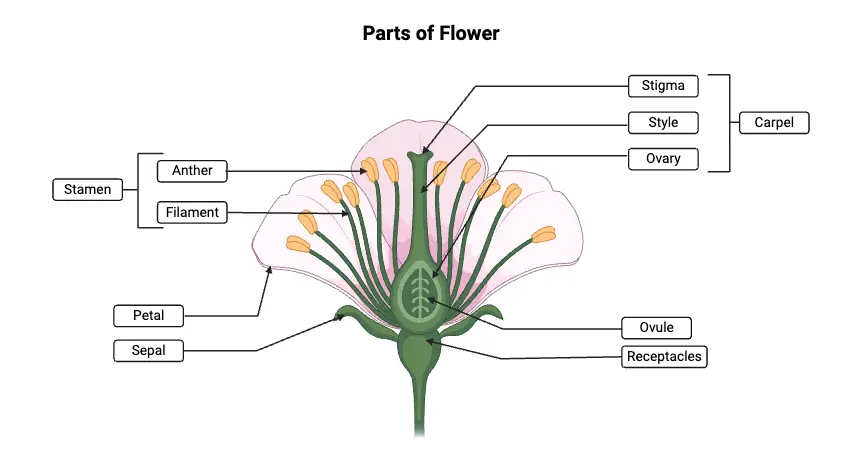
FAQ
What is pollination?
Pollination is the process of transferring pollen grains from the male part (anther) of a flower to the female part (stigma) of the same or another flower. This process is essential for the fertilization and production of seeds in flowering plants.
What are the different types of pollination?
Pollination can be categorized into three main types:
Autogamy: Self-pollination within the same flower.
Geitonogamy: Pollination between different flowers on the same plant.
Allogamy: Cross-pollination between flowers on different plants of the same species.
How can human activities impact pollination?
Human activities such as habitat destruction, pesticide use, and climate change can negatively affect pollinators and their habitats. This can lead to a decline in pollination services, which is critical for food production and maintaining biodiversity. Conservation efforts are essential to protect pollinators and ensure the continued success of pollination processes.
Can pollination occur without pollinators?
Yes, some plants rely on abiotic factors like wind and water for pollination. These plants typically produce large quantities of lightweight pollen that can be easily carried by wind or water to other flowers.
What role do pollinators play in the ecosystem?
Pollinators such as bees, butterflies, and birds are vital for the reproduction of many plants. They help transfer pollen between flowers, enabling fertilization and the production of fruits and seeds. Pollinators are crucial for biodiversity and the health of ecosystems.
What is self-incompatibility in plants?
Self-incompatibility is a genetic mechanism that prevents self-pollination by making the stigma unable to accept pollen from the same flower or plant. This mechanism promotes cross-pollination and genetic diversity.
How does dichogamy prevent self-pollination?
Dichogamy is a natural mechanism where the male and female parts of a flower mature at different times, preventing self-pollination. This temporal separation ensures that pollen is either released before or after the stigma is receptive, reducing the chance of self-fertilization.
What is self-pollination, and what are its advantages?
Self-pollination occurs when pollen from a flower’s anther fertilizes its stigma. The main advantage is that it ensures reproduction even in the absence of pollinators. It also maintains the genetic traits of the parent plant.
Why is cross-pollination important?
Cross-pollination, or allogamy, promotes genetic diversity within a species, leading to healthier and more adaptable plant populations. It allows for the combination of different genetic materials, which can result in improved resistance to diseases and environmental changes.
What are the agents of pollination?
Pollination agents include wind (anemophily), water (hydrophily), insects (entomophily), birds (ornithophily), and animals (zoophily). These agents help transfer pollen from one flower to another, facilitating fertilization.
- Bhojwani SS, Bhatnagar SP (2011). The Embryology of Angiosperms, Vikas Publishing House, Delhi.
- Singh V, Pande PC, Jain DK (2014). A text book of botany: Angiosperms, Rastogi Publication, Meerut
- Gangulee HC, Das KS, Datta C. (2011). College Botany Volume I, New Central Book Agency, Kolkata
- https://extension.missouri.edu/publications/m402#:~:text=When%20a%20bee%20stops%20at,between%20flowers%20results%20in%20pollination.
- https://www.slideshare.net/slideshow/pollination-103222836/103222836
- https://www.britannica.com/science/pollination
- https://www.phytojournal.com/archives/2017/vol6issue5/PartJ/6-4-437-610.pdf
- https://mgcub.ac.in/pdf/material/2020040610165756e04763ab.pdf
- https://www.pw.live/exams/neet/pollination/
- https://courses.lumenlearning.com/wm-biology2/chapter/double-fertilization/
- https://collegedunia.com/exams/types-of-pollination-biology-articleid-7260
- https://www.tutoroot.com/blog/what-are-self-pollination-and-cross-pollination-difference-definition/
- https://collegedunia.com/exams/pollination-by-animals-biology-articleid-9302
